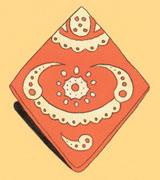Thank You, Unwashed Bandana
By Emily Gold Boutilier
 |
Everyone’s heard about celebrity athletes who wear the same lucky underwear to every game or eat the same strange meal before a big match. Curious, we asked Amherst players and coaches to spill details of their own pre-game rituals and superstitions.
Margaret Meisinger ’11, a diver, was the first to reply to our e-mail. “I always eat a waffle for breakfast before big competitions,” she wrote. “I sit or stand in the same place between dives. I must have my tie-dye chamois with me during the competition. I never watch the other divers; I think it’s bad luck.” Next, tennis player Daniel Kim ’10 weighed in: “I have to wear high socks when I play, and before the match, I’m always wearing my lucky purple Amherst hat.”
 |
As our in-box began to fill, dirty laundry emerged as a theme. Alyssa Dudzik ’09, who’s on the field hockey team, wrote about her gloves: “I never wash them, because it’s bad luck, especially if you’re having a good season. You would not believe how bad they smell: it’s horrendous. But washing them will wash away the good luck! That’s what my mom told me in high school.”
Another theme is loud music. To get hyped up, Brandon Jones ’08 and his classmates on the men’s basketball team would blast music and listen to Al Pacino’s halftime speech from Any Given Sunday. Then, during the national anthem, teammate Fletcher Walters ’08 would remind himself that millions of kids never get to go to college or play sports. “I would also think of all those in the military who were never scared to fight for our country, and it would help put things in perspective,” Walters says. “If they could go die for their country, I should be willing to do everything physically possible to help my team win this game.”
 |
On the road, it’s a tradition for women’s tennis to have a pre-match dance party in the van. Jennifer Murphy ’08 remembers how, after warming up for the NCAA championships at Mary Washington University in 2007, coach Jackie Bagwell ushered the team back into the van. “She played Tom Petty’s ‘I Won’t Back Down,’” Murphy says, “and we danced so hard the van was shaking.” While the tennis players dance, soccer player Lili Ferguson ’10 uses the bus ride to sleep—if only for a few minutes. “When I wake up,” she says, “the only thing on my mind is the game ahead.”
Before every road game, the women’s basketball team eats spaghetti with red sauce and grilled chicken at Olive Garden. The team always does the same drills the day before a game. “This got us into a routine,” says Sarah Leyman ’11, “and helped us have a really successful season.”
 |
Kate Dennett ’10, who plays ice hockey, always ties her right skate first. “And I buckle my right helmet strap before the left one,” she says. Her team made it to the national quarterfinals last season. Are the laces to thank, or does credit belong to coach Jim Plumer’s fedora? Plumer started wearing a fedora to games on Nov. 25, 2006. Since then, he says, “our record against NESCAC opponents is 27-2-7 and we have won back-to-back NESCAC championships.”
At the start of last season, Plumer’s team gave Athletic Director Suzanne Coffey a purple bracelet with the word inches printed on it. She wore it to hockey and basketball games. “Our winter successes certainly had nothing to do with whether or not I had the lucky bracelet on,” Coffey says, “but then again, once it looked like we were winning almost all the time, I was reluctant to attend a game without it!”
What purpose do these rituals serve? Baseball coach Bill Thurston suggests they’re “a form of personal readiness and preparation that gives us confidence and a level of comfort.” But nothing—not even an e-mail from Amherst magazine—will convince Thurston to go public with his own superstitions. “As I’m sure you know,” he says, “baseball players, coaches and managers are very superstitious. So much so, we do not talk about [our superstitions]; they are kept secret.”
 |
For Randi Zukas ’11, another ice hockey player, the rituals are a distraction and a way to ease her nerves. She admits she’s compulsive about her routine: “Maybe it is fear of playing badly if I don’t do them, or maybe it is fear of losing something that I have been able to rely on for such a long time.”
Zukas takes the prize for the most elaborate ritual. She says that the first time she tied her own skates, she followed the lead of her then-coach, who always tied the left skate first. But that day, she played terribly. “The next game,” she says, “I bravely tried tying my right skate first and played great.” The tradition stuck.
Zukas’s list of rituals now reads like an instruction manual: “(1) Stick-handle ball [off the ice] for five minutes, shoot three backhand shots, three wrist shots, pop ball up to hand (never pick it up off the ground). (2) Take stick with me to locker room. (3) Put right sock on, then left sock. Repeat same pattern with shin guards and skates. (4) Put left elbow pad on before the right. (5) Wear lucky bandana, which never gets untied/washed all season. (Yes, it does smell very bad, but it is a necessary evil.) (6) Put gloves on. (7) Say the first cheer in the locker room, skip the second, say the third. (8) Go in the same lines for warm-ups every time—never switch. (9) Tap my friend in the shin guards with my stick. (10) Tap my goalie on both pads between plays, never just one.
“There are a few others,” Zukas continues, “but I think you get the point.”
Illustrations by Marcelo Cipis